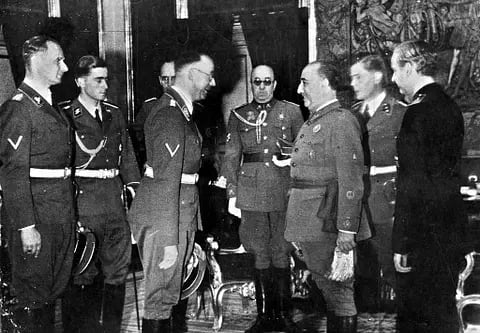Heinrich Himmler: SS Chief, Holocaust Architect & Nazi Leader
Heinrich Himmler, the SS leader who orchestrated the Holocaust and Hitler’s Final Solution. Learn about his role in Nazi genocide, WWII atrocities, and mysterious death.


Introduction
Heinrich Himmler remains one of history’s most infamous figures, synonymous with the atrocities of the Holocaust and the ruthless machinery of Nazi Germany. As the head of the SS (Schutzstaffel) and a key architect of Hitler’s genocidal policies, Himmler’s actions reshaped the 20th century. This in-depth blog uncovers his early life, rise to power, role in WWII atrocities, and enduring legacy.
Who Was Heinrich Himmler? (H2)
Heinrich Himmler (1900–1945) was a leading Nazi official and Reichsführer of the SS, the paramilitary organization responsible for implementing Hitler’s racial policies. A fervent believer in Aryan supremacy, Himmler orchestrated the Holocaust, concentration camps, and the systemic extermination of millions.
Key Facts About Himmler (H3):
Born: October 7, 1900, Munich, Germany
Died: May 23, 1945 (suicide via cyanide)
Key Positions: SS Chief, Gestapo Leader, Minister of the Interior
Notorious For: Holocaust planning, SS expansion, Nazi ideology enforcement
Early Life and Nazi Ideology (H2)
1. Childhood and Education (H3)
Himmler was born into a middle-class Catholic family. His father, a teacher, emphasized discipline, which later influenced Himmler’s rigid worldview. After serving in WWI, he studied agriculture and joined ultranationalist groups, laying the groundwork for his Nazi allegiance.
2. Joining the Nazi Party (H3)
In 1923, Himmler participated in Hitler’s failed Beer Hall Putsch. By 1929, Hitler appointed him SS leader, recognizing his organizational skills and fanatical loyalty.
Rise to Power: The SS and Nazi Germany (H2)
1. Building the SS Empire (H3)
Himmler transformed the SS from a 300-man unit into a 1-million-strong force. Key initiatives included:
Concentration Camps: Establishing Dachau and Auschwitz.
Gestapo Control: Overseeing secret police operations.
Racial Purity Programs: Enforcing eugenics and Lebensborn (Aryan breeding initiatives).
2. The Holocaust and Final Solution (H3)
Himmler chaired the 1942 Wannsee Conference, formalizing the “Final Solution” to exterminate Jews. Under his command:
Death squads (Einsatzgruppen) murdered over 2 million.
Gas chambers systematized mass killings in camps like Treblinka.
Downfall and Death (H2)
1. Defeat in WWII (H3)
As Allied forces closed in, Himmler attempted secret peace negotiations, enraging Hitler. Stripped of power in April 1945, he fled Berlin.
2. Capture and Suicide (H3)
Captured by British troops in May 1945, Himmler bit into a hidden cyanide capsule to avoid trial. His body was buried anonymously.
Heinrich Himmler’s Legacy (H2)
Himmler’s actions left an indelible mark:
Holocaust Leadership: Primary organizer of genocide, responsible for 6 million Jewish deaths.
SS Global Infamy: The SS became a symbol of terror and racial hatred.
Moral Lessons: A stark reminder of authoritarianism’s dangers.
FAQs About Heinrich Himmler (H2)
Q1: What was Himmler’s role in the Holocaust?
A: He designed and executed Hitler’s genocide plans, overseeing camps and death squads.
Q2: How did Himmler die?
A: He committed suicide with cyanide after capture in 1945.
Q3: Was Himmler part of Hitler’s inner circle?
A: Yes, he was among Hitler’s most trusted advisors until his betrayal in 1945.
Q4: What was the SS under Himmler?
A: A militarized group enforcing Nazi racial policies, operating camps, and suppressing dissent.
Conclusion
Heinrich Himmler’s life exemplifies how ideology, bureaucracy, and unchecked power can fuel unimaginable evil. His legacy serves as a grim lesson in the consequences of hatred and totalitarianism. By studying figures like Himmler, we honor victims and reaffirm our commitment to preventing such horrors.